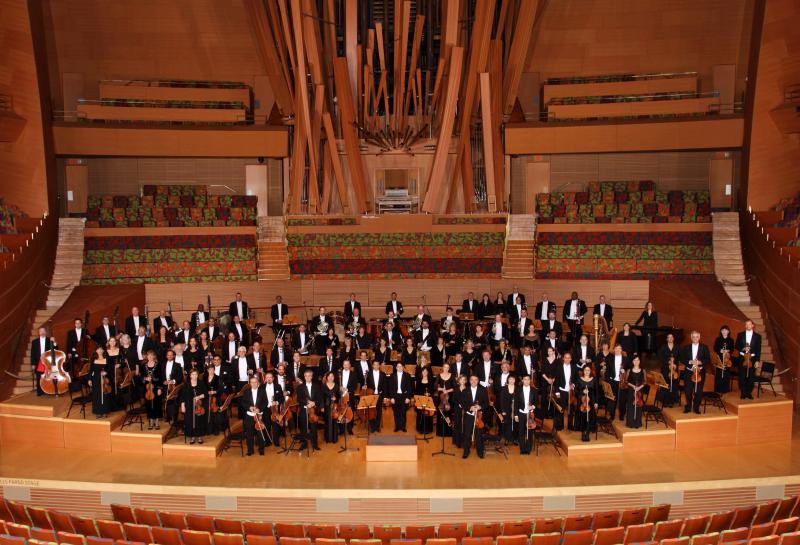Music Review: Juraj Valčuha And Yefim Bronfman At Walt Disney Concert Hall

Tchaikovsky wrote a whole lot of great symphonic music. Several of his most famous works are today so loved and so well-worn that performances have become almost a cliché. But his First Symphony, titled “Winter Daydreams,” is not one of those pieces.
The symphony was Tchaikovsky’s first large-scale professional work, and it shows. The first movement is subtitled “Daydreams of a Winter Journey,” and it is one arduous journey indeed (to be fair, the modes of transportation available in Tchaikovsky’s day were pretty sluggish — so the title makes some sense).
It seems that when he is at a loss for ideas, the young Tchaikovsky just kind of repeats things until something better comes up. To mark the climax of the movement, he pounds out seven g-minor chords in a row, along with a big ol’ g-minor scale in the lower strings, played simply from bottom to top. Now, that’s just going nowhere fast.
When Tchaikovsky does manage to move it along, the destination is never much of a surprise. Harmonic development is clumsy and unnecessarily protracted. Aside from his peculiar main theme — an anxious little winding ditty that comes back again and again — Tchaikovsky’s thematic material is largely made up of either straight-up scales, or three-note licks that move up or down in scale-like fashion. It’s banal stuff.
Valčuha didn’t help matters any with a mostly rigid reading of the work. His baton technique appeared stiff, almost sclerotic, at times. Though the orchestra never lost any of their polish, there was a discernible disconnect between the leadership and the musicians.
The slow parts of the symphony are the best, so the pensive second movement — if at times too prolix for its distinctively Russian melody — faired much better. So did the introduction to the fourth movement — a plaintive meditation on a spare, brooding motif. Valčuha seemed more comfortable with this music, particularly when others took the lead. The oboe solo in the slow movement — joined by wistful counter-melodies in the bassoon and flute — was some of the best playing all evening.
In these song-like moments, there are hints of the Tchaikovsky that is to come — the Violin-Concerto-Canzonetta-Tchaikovsky, or the Fourth-Symphony-Andantino-Tchaikovsky. But, for the most part, Symphony No. 1 gives us timid-Tchaikovsky, not yet willing to spin out those big, lingering melodies, or doleful, drawn-out, Tchaikovskian refrains.
That’s too bad. But there is always a learning curve — not every piece can be a masterpiece. That’s why you might hear a dozen performances of Mendelssohn’s popular E Minor Violin Concerto, before hearing of the D Minor Concerto (he wrote it at 13). And it’s why performances of Mozart’s earliest symphonies are pretty scarce.
But performances of Brahms’ Piano Concerto No. 2 aren’t, and for good reason. This is big-kid music. At around 50 minutes long, it’s a behemoth of a concerto, but with none of the dawdling one finds in the Tchaikovsky.
The concerto opens with a reverential, eight-note horn call. A supple, almost innocent response comes from the piano at first — but once it gets rolling, the thing takes off and doesn’t land until Brahms has served up every last morsel those eight notes have to offer.
Unfortunately, Bronfman — who canceled a Carnegie Hall recital last month due to exhaustion — never managed to get the piece off the ground. Valčuha did his best to help it along, shedding his earlier stiffness in favor of a pliant, generous accompaniment. But the piano playing was lethargic, at times even clumsy, and there was very little of the usual Bronfman muscle that audiences have come to expect.
In the fiery music of the scherzo movement (something of a bonus, as scherzos are usually reserved for symphonies rather than concertos) Bronfman couldn’t seem to cut through the orchestral texture, so the fretted pronouncements of the piano were simply lost in a wash of sound.
In the slow movement, however, Bronfman demonstrated that, even on a sub-par evening, he can still be a brilliant musician. Bookended by two divine cello solos, the glorious piano melodies unfolded in an enchanting slow motion. Bronfman weaved his way in and out, finishing a string sentence here and an oboe sentence there. In many ways, Bronfman’s somewhat sleepy playing on this particular evening — not so good for the fast stuff — was actually quite well suited to the slow music. He held tight to the backside of Valčuha’s beat, spreading Brahms’ melody out thick — delaying each resolution until the absolute last, most satisfying, moment.
But the final movement came off just as the first two. Clunkers were everywhere, the tone was spongy, and all the playful music was decidedly straight-laced.
It’s a shame, because Bronfman is a great artist who knows how to play a great concert. But off-nights happen, and a first-rate pianist like Bronfman will surely step it up next time. After all, that’s just part of growing up. And musicians are never done growing up.
Reach Jason Issokson here.



